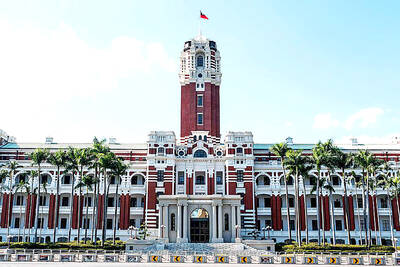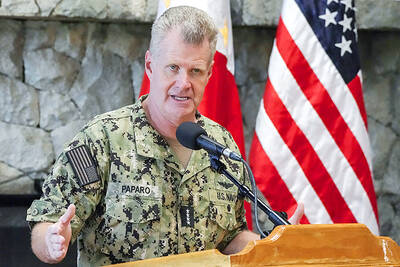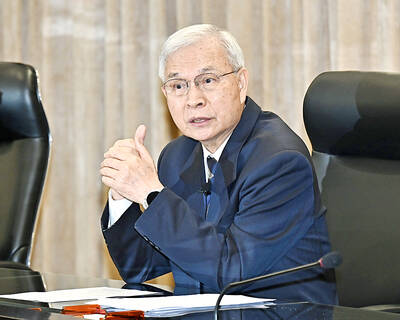Chinese President Hu Jintao (
In the second meeting this month between a Taiwanese opposition leader and Hu in his capacity as Chinese Communist Party (CCP) chairman, Soong and Hu met for an hour yesterday in Beijing.
Speaking at a press conference held directly after the talks, the PFP announced the six points of the communique forged in the meeting.
In the first point, the two parties agreed on the importance of resuming cross-strait negotiations on the basis of the "1992 consensus," and specifically detailed the supposed origin and content of the consensus, as formed in the 1992 talks between the Chinese Association for Relations Across the Taiwan Strait (ARATS) and the Straits Exchange Foundation (SEF) of Taiwan.
The "1992 consensus" refers to an alleged agreement between negotiators from ARATS and SEF to hold talks under the mutual agreement of the "one China" principle, but with different interpretations of what that meant.
While the pan-blue camp has claimed that the consensus should serve as the basis for talks between Taiwan and China, the current administration has consistently said that it does not recognize the "1992 consensus," since it was never formally stated or agreed upon.
The communique added a new term in parentheses -- "two sides of the strait, one China" -- next to the words "1992 consensus," which the statement said highlighted the specific oral descriptions by the SEF and ARATS in their agreement, which it said was later dubbed the "1992 consensus."
"Equal, cross-strait negotiations should be swiftly resumed on the `one China' principle with individual interpretations described above [referring to the oral descriptions attributed to SEF and ARATS] to pragmatically solve important issues of common concern for both sides of the strait through mutual respect and co-existence," PFP policy research center director Chang Hsien-yao (
Second, the parties agreed on their common opposition to Taiwan's independence and common plan to pursue peaceful stabilization in the Taiwan Strait. While saying that Taiwan's independence movement is damaging to the stability and safety of the Taiwan Strait and the Asian region, the two parties then called on "Taiwan's current leader" -- presumably a reference to President Chen Shui-bian (陳水扁) -- to fulfill his promises, reiterated during a meeting between Chen and Soong, including the "four noes," and to promise not to amend the Constitution.
"Only if there is no possibility that Taiwan is heading toward independence, can there be the effective avoidance of military conflict in the Taiwan Strait," the statement said.
Third, the parties agreed to end the standoff between the two sides of the Strait, and to facilitate the establishment of cross-strait peace mechanisms, including establishing a peace agreement and a mechanism to address military affairs between the countries on either side of the Strait.
Fourth, the statement called for the strengthening of business exchanges between China and Taiwan and the establishment of a system to facilitate economic cooperation. Such economic cooperation, the PFP said, should include facilitating the establishment of cross-strait flights by next year and the establishment of a free trade area for Taiwan and China.
Additional economic proposals in the communique included creating equal tuition standards for Taiwanese students studying in China, the establishment of Chinese scholarships for such students, the facilitation of entry and exit into China by Taiwanese citizens and the simplification of visa regulations, and various proposals to simplify agricultural co-operation.
Fifth, the PFP and the CCP agreed to seek a resolution of the problems facing Taiwanese participation in international organizations, specifically in regards to Taiwan's entry into the World Health Organization (WHO).
Sixth, the two agreed to facilitate the establishment of a forum for experts and leaders of both sides of the Strait.
In order to facilitate all of the communique's points, Soong said at the PFP's press conference, the CCP and the PFP further plan to establish a communication platform between the parties to continue discussing the realization of their common goals.
Given previous rumors that Soong would seek to redefine the controversial "1992 consensus" in his meeting with Hu, and that he would bring Hu a message from Chen, the first and second points of the communique were the focus of media attention yesterday.
"This is the first time that China has said clearly in a communique that it supports the `one China' principle with different interpretations," Soong said, further emphasizing the use of the newly-coined term "two sides of the Strait, one China" in the communique.
The interdependence of Taiwan and China is greater than most imagine, Soong said, stressing the importance of resuming talks under the intended meaning of the "1992 consensus."
The PFP has always hoped to solve problems and helped to stabilize the Taiwan Strait through sincere communication, mutual respect and a common desire for mutual benefit, Soong said.

The CIA has a message for Chinese government officials worried about their place in Chinese President Xi Jinping’s (習近平) government: Come work with us. The agency released two Mandarin-language videos on social media on Thursday inviting disgruntled officials to contact the CIA. The recruitment videos posted on YouTube and X racked up more than 5 million views combined in their first day. The outreach comes as CIA Director John Ratcliffe has vowed to boost the agency’s use of intelligence from human sources and its focus on China, which has recently targeted US officials with its own espionage operations. The videos are “aimed at

STEADFAST FRIEND: The bills encourage increased Taiwan-US engagement and address China’s distortion of UN Resolution 2758 to isolate Taiwan internationally The Presidential Office yesterday thanked the US House of Representatives for unanimously passing two Taiwan-related bills highlighting its solid support for Taiwan’s democracy and global participation, and for deepening bilateral relations. One of the bills, the Taiwan Assurance Implementation Act, requires the US Department of State to periodically review its guidelines for engagement with Taiwan, and report to the US Congress on the guidelines and plans to lift self-imposed limitations on US-Taiwan engagement. The other bill is the Taiwan International Solidarity Act, which clarifies that UN Resolution 2758 does not address the issue of the representation of Taiwan or its people in

US Indo-Pacific Commander Admiral Samuel Paparo on Friday expressed concern over the rate at which China is diversifying its military exercises, the Financial Times (FT) reported on Saturday. “The rates of change on the depth and breadth of their exercises is the one non-linear effect that I’ve seen in the last year that wakes me up at night or keeps me up at night,” Paparo was quoted by FT as saying while attending the annual Sedona Forum at the McCain Institute in Arizona. Paparo also expressed concern over the speed with which China was expanding its military. While the US

SHIFT: Taiwan’s better-than-expected first-quarter GDP and signs of weakness in the US have driven global capital back to emerging markets, the central bank head said The central bank yesterday blamed market speculation for the steep rise in the local currency, and urged exporters and financial institutions to stay calm and stop panic sell-offs to avoid hurting their own profitability. The nation’s top monetary policymaker said that it would step in, if necessary, to maintain order and stability in the foreign exchange market. The remarks came as the NT dollar yesterday closed up NT$0.919 to NT$30.145 against the US dollar in Taipei trading, after rising as high as NT$29.59 in intraday trading. The local currency has surged 5.85 percent against the greenback over the past two sessions, central